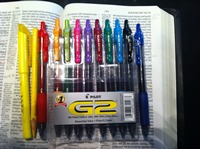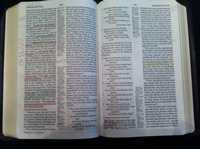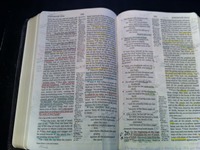Do you have a system for marking your Bible as you study? Over the years, I've found that if I want to layer reading upon reading and go deeper each time, it helps me to mark my Bible and build on my earlier study notes.
As I read the Bible, I try to make note of repeated words, resumed themes, quotations of earlier passages, and other key ideas. But I don't want simply to see them and move on. I want to highlight them. This helps me recall connections I've seen, and helps me find those key ideas later. Whenever I want an uninfluenced, fresh reading of a Bible passage, I use an unmarked copy.
I try to read large chunks of Bible all at one sitting, whole books if possible, and thoroughly mark them up as I go. Doing this book after book brings out the interconnectedness of individual books and the thick intertextuality of each book of the Bible with all the others.
So, here's what I like to do when marking my Bible. I use a mechanical pencil, a set of colored pens, colored pencils, and occasionally a highlighter to note things. As I've done this over the years, I've developed a color code for key ideas:
Orange = references to God's glory or name
Green = references to earlier Scripture, whether quotations or otherwise
Purple = references to royalty/kingship/the coming Messiah
Red = anything notable, but particularly the actions the Lord himself does
Blue = references to faith, believing, piety, etc.
Pink = knowing or fearing God/the Lord
Yellow (colored pencil) = anything notable, repeated words in the passage, etc.
Brown (colored pencil) = references to times or dates
Mechanical Pencil =
notes in the margin, underlines, connecting lines, etc.
(To enlarge, hold Ctrl +)

Those are the constants. Some colors vary from book to book, but these are pretty standard throughout. For instance, I recently re-read Proverbs all at one sitting with the intention of noting everything the book says about raising children. I marked all those references with a lime green color, and all the references to the "path" of the righteous or to the "ways" of a man with an aqua green color. And since Proverbs has a few unique "headings" (Proverbs 1:1; Proverbs 10:1; Proverbs 22:17; Proverbs 24:23; Proverbs 25:1; Proverbs 30:1; Proverbs 31:1) I used a highlighter to mark those. Bible pages tend to be thin, so I try to keep a highlighter that is almost used up to reduce the bleed-through effect.
Here's a photo of a passage before I studied and marked it. Notice that the marked-up passage in the column on the far left ends at Jeremiah 25:14. That's where my last sermon on Jeremiah ended. I took this photo right before I began to study Jeremiah 25:15-38, which was the next sermon in my preaching series. Jeremiah 25:15-38 begins at the bottom of the far left column and continues through the two columns in the middle.
(To enlarge, hold Ctrl +)

As I worked through the passage, I underlined all the places where Jeremiah has something like "Thus says the Lord" in green colored pencil (see Jeremiah 25:15, Jeremiah 25:27, Jeremiah 25:29, Jeremiah 25:31, Jeremiah 25:32). (I had already underlined Jeremiah 26:1 in brown colored pencil because it has a statement about when Jeremiah got this word, and the green colored pencil is there because of the reference to the way the word came from the Lord.)
As I read and re-read the passage, I noticed that in both 25:16 and 27 Jeremiah is told to command the nations to "drink . . . because of the sword that I [Yahweh] am sending among you," so I underlined the matching phrases in the two verses with an aqua green colored pencil.
Cities and nations are listed out in Jeremiah 25:18-26, with some comments on each. So I underlined each city or nation mentioned in yellow colored pencil.
Jerusalem was to be a city that reflected Yahweh's glory, from which his glory radiated outward, so I underlined the reference in Jeremiah 25:29 to "the city that is called by my name" in orange pen.
In Jeremiah 25:30 the Lord twice roars like a lion, and I've circled those in mechanical pencil, drawing a line from that verse to 25:38, where similar imagery is used, and noting that Yahweh also roars like a lion in Amos 1:2, Joel 3:16, and Hosea 5:14.
I have also noted next to Jeremiah 25:33 places where Jeremiah says similar things at 16:4 and 8:2.
Then in Jeremiah 25:34-36 there are several references to the "shepherds" who are the "lords of the flock," and these are underlined in jade green colored pencil. The two calls for these wicked leaders of Israel to "wail" are underlined with a mechanical pencil, with a line connecting them. Here's a photo of the page I've been describing:
(To enlarge, hold Ctrl +)

I've marked up several copies of the Bible this way. When I teach, I want to have a copy of the Bible in front of me that has everything that I will have a faint memory of clearly marked so that I can find it (relatively) quickly. When I'm asked a question, and I know I read about that somewhere around Luke 12, I go to Luke 12 and can find what it was I had in mind because I usually remember, however faintly, what I've marked.
Obviously you don't have to mark your Bible exactly the way I do, but perhaps seeing this method will spur your own thinking and help with your own study.
Mark well what you read, and may the Word of Christ dwell in you richly! (Colossians 3:16)
(Article first published on August 5, 2012)
Further Reading:
10 Things You Should Know about Studying the Bible
25 Bible Study Books and Resources for Beginners
4 Solid Tips for Getting Started with Bible Study
Bible Studies for Women to Grow Spiritually
3 Fresh Ways to Study Your Bible
Crosswalk.com Bible Study Articles Archives
8 Tips for Studying God's Word
Photo Credit: ©GettyImages/Grace Cary
This article is part of our Bible resource for understanding the significance and meaning of biblical phrases and ideas. Here are our most popular Bible articles to grow in your knowledge of God's Word:
Promises of God in the Bible
Is "This Too Shall Pass" in the Bible?
What Was the Ark of the Covenant?
Top 10 Bible Stories for Kids
“Iron Sharpens Iron” in Proverbs 27:17
"Fearfully and Wonderfully Made" in Psalm 139
“Be Still and Know That I am God” in Psalm 46:10
"No Weapon Formed Against Me Shall Prosper" - Isaiah 54:17


.png)
